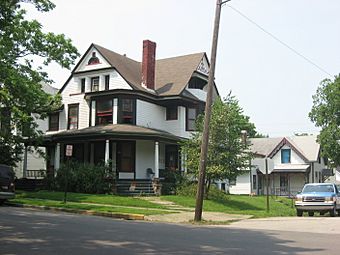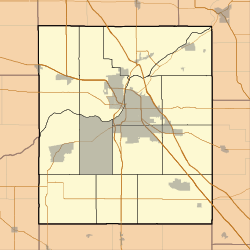Ellsworth Historic District facts for kids
Quick facts for kids |
|
|
Ellsworth Historic District
|
|

Sixth and New York in Lafayette, June 2011
|
|
| Location | Roughly bounded by Columbia, Norfolk & Western RR tracks, Alabama, Seventh, South and Sixth Sts., Lafayette, Indiana |
|---|---|
| Area | 34 acres (14 ha) |
| Architectural style | Bungalow/craftsman, Late Victorian |
| NRHP reference No. | 86003501 |
| Added to NRHP | December 30, 1986 |
The Ellsworth Historic District, also known as Ellsworth Addition, is a special area in Lafayette, Indiana. It's called a historic district because it has many old buildings that are important to history. This district covers about 34 acres and includes 144 buildings, one site, and four structures that help tell the story of the past.
This neighborhood grew between 1844 and 1936. It shows off different building styles from those times. You can see examples of Italianate, Second Empire, Queen Anne, and Bungalow / American Craftsman styles. Some very famous buildings, like the Falley Home, Moses Fowler House, and Temple Israel, are found here.
Contents
Discovering the Ellsworth Historic District
The Ellsworth Historic District is like a living museum. It helps us understand what life was like in Lafayette many years ago. It's a great place to explore and see how architecture changed over time.
A Look at Its History
The district started to develop around 1844. This was a time when Lafayette was growing. New homes and buildings were being built. The area continued to grow until about 1936. This long period means you can see many different styles of buildings. Each one tells a part of the city's story.
Amazing Architecture Styles
The buildings in Ellsworth Historic District show off several cool architectural styles. These styles were popular at different times. They make the neighborhood unique and interesting to look at.
Italianate and Second Empire
- Italianate style buildings often have tall, narrow windows. They might have decorative brackets under the roof. These homes look a bit like Italian villas.
- Second Empire style buildings often have a special kind of roof called a mansard roof. This roof has slopes on all sides. It often has dormer windows sticking out. These buildings look grand and fancy.
Queen Anne and Bungalow/Craftsman
- Queen Anne style homes are usually very colorful and detailed. They often have turrets (small towers), bay windows, and fancy porches. They look like something out of a fairy tale.
- Bungalow and American Craftsman styles became popular later. These homes are usually smaller and more practical. They often use natural materials like wood and stone. They have a cozy, handcrafted feel.
Famous Buildings in the District
Many important buildings are located within the Ellsworth Historic District. Some of these are so special that they are listed separately.
- The Falley Home is one of these important buildings.
- The Moses Fowler House is another well-known landmark.
- Temple Israel is also a significant part of the district.
Other notable buildings include:
- The Second Presbyterian Church (built 1894-1895)
- The Alexander House (around 1880)
- The Ball Brothers House (around 1845)
- The Falley Townhouse (around 1892)
- The Home Block (around 1870)
- The Annie Fowler House (around 1870)
- The Duplex Townhouse (around 1890)
These buildings show the different styles and how the area grew. They are all part of what makes this district historic.
Why is it a Historic Place?
The Ellsworth Historic District was officially listed on the National Register of Historic Places in 1986. This is a special list kept by the United States government. Being on this list means the district is important to the history of the country. It helps protect these old buildings and ensures they can be enjoyed for many years to come.




